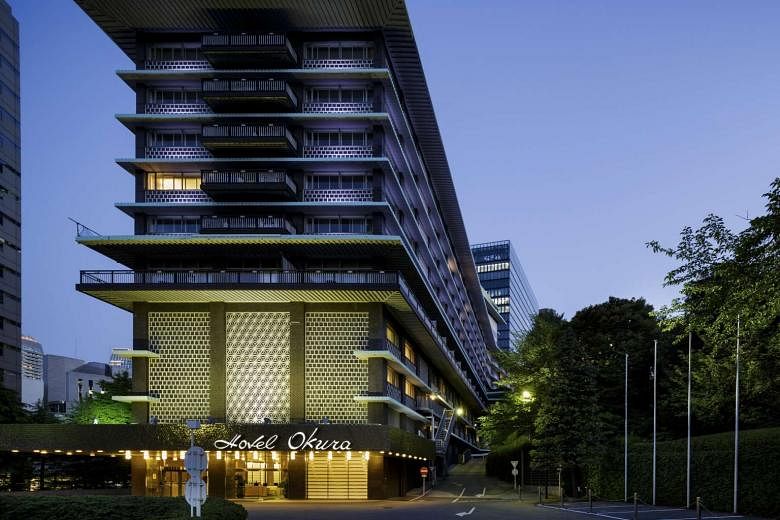TOKYO • The outcry over the demolition last year of the 53- year-old Hotel Okura in Tokyo surprised no one more than some Japanese historians and architectural specialists.
Monocle, the global lifestyle magazine, had circulated a petition, savetheokura.com, to register the "outrage from admirers of its unique design".
Mr Tomas Maier, the creative director of Bottega Veneta, an Italian luxury brand, filmed a video memorial and started a social media campaign,#MyMomentAtOkura.
The hotel's modernist postwar lobby artfully balanced elements of traditional Japan, such as lacquered plum blossom-shaped tables and chairs, with visions of what was then futuristic, like a lighted world map displaying global time zones.
It was frequented by United States presidents and heads of state, celebrities, artists and designers. It played a central role in the 1960s James Bond novel, You Only Live Twice.
Hotel Okura's largest investors are Taisei Corporation, a construction company; and Mitsubishi Estate, Japan's second largest real estate developer. It plans to build a 38-storey high-rise with 510 rooms, 102 more than the Okura, and add 18 storeys of office space.
The renovation is estimated to cost US$1 billion (S$1.43 billion).
The company promised to "faithfully reproduce" several beloved artefacts in the lobby, including wall tapestries, paper lanterns and sliding doors, and the lacquered furnishings and map of time zones.
The hotel's main building and its lobby were demolished last September. The South Wing will remain operational and the owners plan to replicate the lobby's mezzanine floor and its ceiling lights. A newly designed bar will try to recapture the retro-chic of the former Orchid Bar, the Okura's elegant, dimly-lit cocktail haven loved by diplomats, expatriates and journalists.
The new complex will be designed to meet the latest standards in earthquake-resistant construction technologies.
But those plans have done little to assuage the concerns of preservationists, who contend that Tokyo is destroying its greatest postwar architectural assets to accommodate the 2020 Olympics and a recent surge in tourism.
The Okura opened in 1962, two years before the first Tokyo Olympics, an event that showed the world Japan had recovered from the devastation of World War II. It was erected across the street from the American Embassy.
Architect Yoshiro Taniguchi led a design team appointed by Mr Kishichiro Okura, the founder.
Unlike many postwar Tokyo buildings, the Okura was built to evoke Japanese-ness. Recreating it is the architect's son, Mr Yoshio Taniguchi, a Harvard graduate who redesigned the Museum of Modern Art in New York 11 years ago.
He is keenly aware of the affection bestowed upon his father's Okura. He says he can incorporate the spirit and feel of the original in the new building. "There were many examples of excellent modern architecture in postwar Japan," he said. "But there are also many that have become rundown. For structures that were beautiful and original, we are trying to restore them with sensitivity to their original forms."
Professor Hiroshi Matsukuma of the Kyoto Institute of Technology, a champion of postwar modernism, sees the virtues of Tokyo architecture in its layers of history.
Tokyo's major edifices of the 20th century were modest in comparison with other global cities. But they embodied the organic, rapid growth of the city's reconstruction.
Projects undertaken since 2000 tend to be massive, multipurpose skyscrapers. Prof Matsukuma wrote: "The multi-layeredness of Tokyo is something we may be losing in our city's major centres. You can find it only in the back streets and old neighbourhoods - they are disappearing too."
Another challenge is that Tokyo has a shortage of hotel rooms. The number of foreign visitors to Japan was expected to near a recordbreaking 20 million by the end of last year, an increase of more than 40per cent.
Occupancy rates for Tokyo hotels are 90 per cent or higher. Domestic businesses have complained that their travelling salarymen can no longer find affordable rooms.
The number of Asian tourists to Japan has exploded in the last year. China accounted for 4.7 million visitors, a 109 per cent spike in one year.
The small number of additional rooms planned for the reconstructed Okura will do little to mitigate a trend that is forcing Tokyo to embrace another 21stcentury development. Airbnb announced in November that Japan was by far its fastest-growing market.
NEWYORK TIMES

